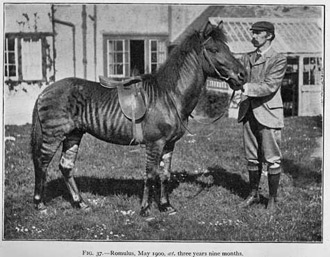Harriet Ritvo
Noble Cows & Hybrid Zebras: Essays on Animals & History
University of Virginia Press
256 pages, 6 x 9 inches
ISBN 978 0813930602
Disciplines like zoology and veterinary medicine have always taken animals seriously as the subject of research. In the humanities and social sciences, the field sometimes known as “animal studies” began to emerge in the 1980s, and it has flourished and diversified in the subsequent decades.
The essays collected in Noble Cows and Hybrid Zebras were written over this same period. They illustrate the evolution of the field, as well as my own evolution as a historian. A few of the essays deal with contemporary issues such as mad cow disease and the use of animals in laboratory experiments. Most of the essays, however, focus on British history.
Within this focus, these essays engage a wide variety of topics. For example, the noble cows of the title were (and are) a small group of white cattle with black ears, claimed by their aristocratic owner to have descended directly from the aboriginal bovine ancestors, without the intervening humiliation of domestication. The hybrid zebras of the title were crosses with horses and ponies, produced by a Scottish zoologist at the end of the nineteenth century to disprove the widely believed theory of telegony or influence of the previous sire (the belief that the father of a female’s first child would somehow influence her subsequent offspring by different fathers).
In addition to zoology and animal husbandry, the essays in the volume also offer historical perspective on the fields of veterinary medicine, gender studies, and comparative psychology.

Much of the value of studying the role of animals from the perspective of the humanities and social sciences comes from their paradoxical position—they are ubiquitous but invisible, essential but unacknowledged, like us but irrevocably different.
When I began work on my first book, animals were not universally acknowledged as respectable subjects of historical research. The book was published by Harvard University Press in 1987, and titled The Animal Estate: The English and Other Creatures in the Victorian Age. One colleague commented that “many weird things have come out of the humanities lately, but this is the weirdest.”
By the time that my next book about animals appeared, The Platypus and the Mermaid, and Other Figments of the Classifying Imagination, also published by Harvard, in 1997, people weren’t saying such things any more, at least not for publication. The significance of animals, both as historical actors on their own account, and as proxies for people, had been well established. And a critical mass of scholars interested in the role of animals has emerged in disciplines from philosophy to sociology.
But much of the value of studying the role of animals from the perspective of the humanities and social sciences comes from their paradoxical position—they are ubiquitous but invisible, essential but unacknowledged, like us but irrevocably different. In consequence, in dealing with animals, whether in words or in actions, people tend to reveal assumptions about each other, as well as about the creatures that are their explicit focus.
Despite its recent growth, the study of the relations between people and other animals is still far from the recognized core of the humanities and social sciences. It remains marginal in most disciplines, and (not the same thing) it is often on the borderline between disciplines. This double marginality allows the study of animals to challenge settled assumptions and relationships—to re-raise the largest issues, both within the community of scholars and in the larger society to which they and their subjects belong.
One of the largest is the definition of “animal” itself. Most scholars who write about such subjects, myself included, think that humans are also animals, and so the focus of our research should be understood as “other animals.” The consequence of this expanded understanding is to eliminate the problematically binary human/animal opposition. But the binary tends to reemerge in several different contexts.
My own work focuses on mammals, in large part because they are most closely associated with people in daily experience and in thought and rhetoric. For example, when Victorian breeders castigated the lasciviousness of their female animals, or bemoaned their reluctance to accept the mates selected for them, they channeled the outrage of the flouted paterfamilias, faced with a daughter who stubbornly insisted on charting her own romantic course—thus conflating the willful maiden with the intransigent mare or bitch.
Other zoological categories—for example crustaceans or nematodes—are incontestably animals, but their relationship to people is very different. While this may not be significant from a biological perspective, it turns out to matter greatly in some practical contexts, such as the persuasive impact of arguments against the mistreatment of animals.
Related problems crop up when the subject of definition is not “animal” but “the animal.” Since the implicit comparison is “the human,” such attempts have the effect, whether intended or not, of reinforcing or resuscitating the human/animal binary.
Cossar Ewart and his stud zebra. (Image courtesy of the author’s archive.)

The essays collected in Noble Cows and Hybrid Zebras share a focus on animals but within that general topic, they vary greatly. So a reader most interested in contemporary issues would be drawn first to different selections than would a reader most interested in the history of science.
If I had to choose a single essay that distills the central themes of the book—and that also represents my interest in environmental history—it would be the penultimate essay, “Counting Sheep in the English Lake District.”
Beginning with the foot and mouth epidemic of 2001, which resulted in a widely publicized assault by the British army on the Herdwick sheep who graze unrestrained on the uplands of northwest England, this piece considers how that breed came to symbolize its apparently wild homeland, in preference, for example, to the red squirrel or the otter. This symbolism is multiply complex. Not only are the sheep demonstrably non-indigenous and incontestably domesticated, but their rugged environment also is less wild, or at least more modified by human society and economy, than it appears. Indeed, it has been largely modified by the sheep, who, for the last millennium, have prevented the re-growth of tree cover by their incessant nibbling. So like the sheep, the landscape itself is only wild by assertion and convention; the Herdwicks may after all be its most appropriate representatives.

Often important commitments are expressed in controversies over classification.
The issues raised by the historical and contemporary experiences of other animals, and by our understanding of those experiences, have continuing significance.
Often important commitments are expressed in controversies over classification. The most conspicuous such controversy has focused on the position of humans within or without the animal kingdom, especially as demonstrated by Charles Darwin’s theory of evolution by natural selection.
But there are others. The creation and limitation of breeds and the enforcement of breed standards has a clear relation to ideas about the robustness and differentiation of human races. The distinction between domesticated and wild animals is at least equally problematic, and its political implications are more multifarious. Depending on how the opposed elements are valued, it can be used to argue for or against development—for or against conservation.




We don't put paywalls. We don't distract you with ads. We don't sell your data.
Please help to keep this running!